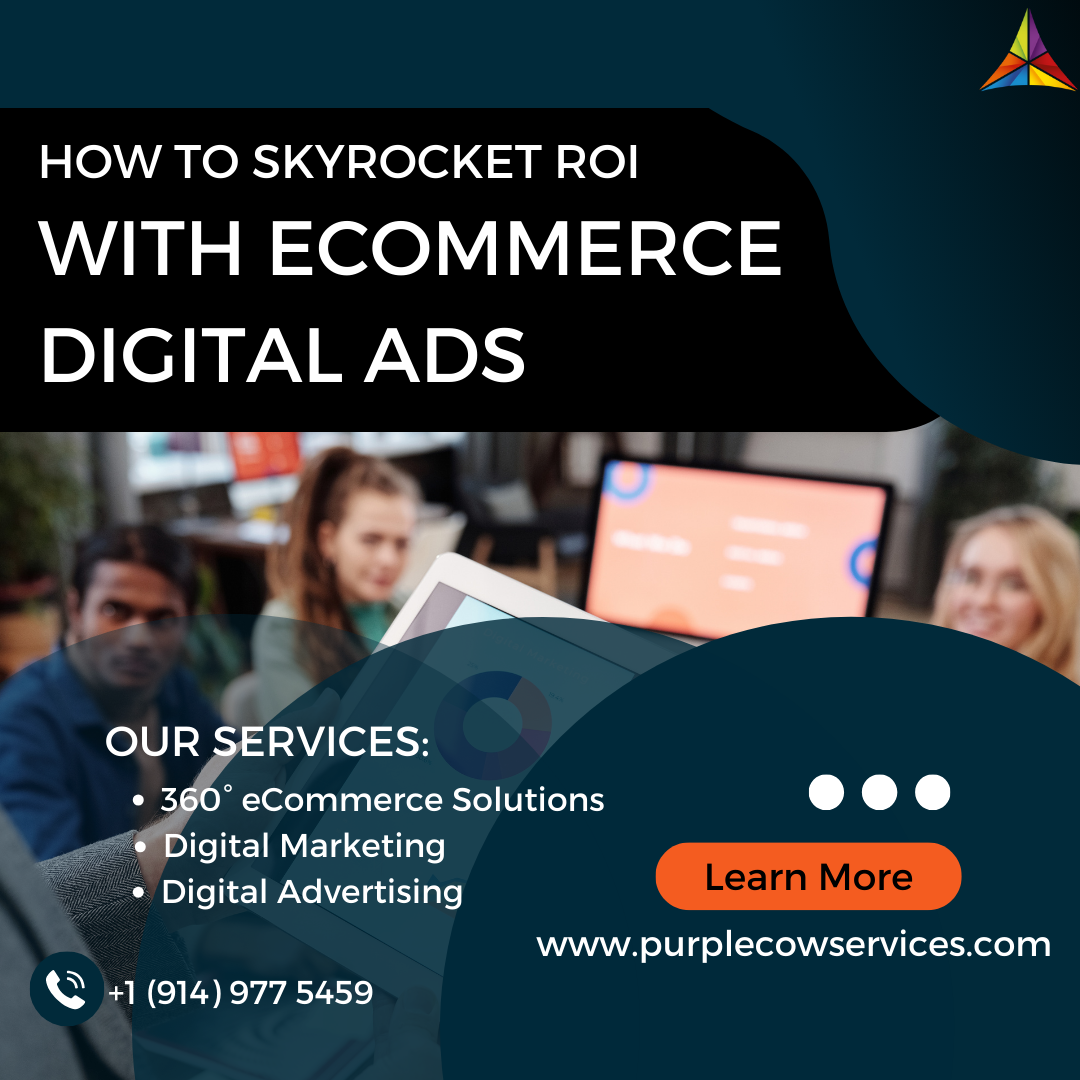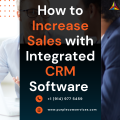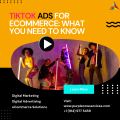When it’s done right, it has the potential to skyrocket your Return on Investment (ROI) and make your eCommerce business thrive. In this comprehensive guide, we’ll explore the strategies, tactics, and best practices that will help you master the art of digital advertising for eCommerce and, ultimately, boost your ROI.
The ROI Game Plan
Before you dive into the world of digital advertising for your eCommerce business, it’s crucial to establish a solid game plan. ROI (Return on Investment) is your ultimate goal, but achieving a high ROI requires careful strategy, meticulous execution, and continuous optimization.
Definition of ROI: In the realm of eCommerce digital advertising, ROI is the metric that measures how effectively your advertising campaigns are performing. It’s not just about getting clicks or impressions; it’s about generating revenue from those interactions. The ROI formula is straightforward: (Net Profit / Cost of Ad) x 100. This percentage tells you the return on every dollar invested in advertising.
Importance of Maximizing ROI: Why should you care about maximizing ROI? Well, it’s the linchpin of your advertising efforts. Maximizing ROI means you’re getting the most value out of every advertising dollar spent. It translates to increased profits, sustainable growth, and a competitive edge in the eCommerce landscape.
Define Your Objectives
Your eCommerce digital advertising journey begins with setting clear and well-defined objectives. What do you want to achieve with your ad campaigns? Is it to boost sales, increase website traffic, improve brand awareness, or perhaps a combination of these goals? The key is to set SMART objectives:
Specific: Your objectives should be crystal clear. Vague goals won’t provide the direction you need. For example, if you want to boost sales, specify by how much and within what timeframe.
Measurable: Objectives should be quantifiable. Use metrics like revenue, conversion rate, or traffic volume to track your progress.
Achievable: While ambition is great, your goals should also be realistic. Don’t set yourself up for disappointment by aiming for unattainable results.
Relevant: Your objectives should align with your overall business goals. Ensure that they contribute to your eCommerce success.
Time-bound: Set deadlines for achieving your objectives. A timeframe creates urgency and keeps you on track.
For example, if you’re launching a new product line, your objective might be to increase sales by 20% within the next three months. This specific, measurable, achievable, relevant, and time-bound goal sets the stage for your advertising strategy.
Key Performance Indicators (KPIs)
With your objectives in place, the next step is to identify the Key Performance Indicators (KPIs) that will serve as your compass throughout your eCommerce digital advertising journey. KPIs are the metrics directly related to your goals, and they provide actionable insights into your campaign’s performance.
Conversion Rate: This metric tracks the percentage of website visitors who take a desired action, such as making a purchase. A high conversion rate indicates that your ad campaigns are effectively driving users to complete the desired action.
Click-Through Rate (CTR): CTR measures the ratio of users who click on your ad to the total number of users who see it. It’s a crucial indicator of ad engagement and relevance. A higher CTR suggests that your ad copy and visuals resonate with your audience.
Cost per Acquisition (CPA): CPA is the cost incurred to acquire a new customer through your ad campaign. It’s calculated by dividing the total campaign cost by the number of new customers acquired. A lower CPA indicates efficient ad spend.
These KPIs provide valuable insights into the performance of your digital advertising efforts. Regularly monitor them, and be prepared to make adjustments to your campaigns as needed to maximize ROI.
Know Your Audience
One of the most powerful aspects of digital advertising for eCommerce is the ability to target your audience with pinpoint precision. To do this effectively, you need to create detailed buyer personas.
Creating Buyer Personas: Buyer personas are fictional representations of your ideal customers. They go beyond demographics and include factors such as interests, behaviors, pain points, and motivations. For instance, you might create personas like “Savvy Susan,” representing tech-savvy shoppers, and “Budget-Conscious Bob,” representing cost-conscious consumers.
Tailoring Ads for Different Segments: Once you’ve created these personas, you can tailor your ad campaigns to different segments of your audience. For example, you might use different messaging and visuals for “Savvy Susan” than you would for “Budget-Conscious Bob.” This level of personalization enhances the relevance of your ads and increases the likelihood of conversions.
By understanding your audience segments, you can craft ads that resonate on a deeper level, making your digital advertising efforts more effective and your ROI more impressive.
Crafting Compelling Ad Copy
Your ad copy is the voice of your brand in the digital world. It’s your opportunity to connect with potential customers, convey your value proposition, and persuade them to take action. Here are some strategies for crafting compelling ad copy:
Speak to Pain Points: Effective ad copy addresses the pain points and challenges that your product or service can solve. It demonstrates that you understand your audience’s needs and have a solution.
Use Persuasive Language: Active voice and persuasive language can make your ad copy more compelling. Instead of saying, “Our product can help you,” say, “Transform your life with our product.” The latter is more assertive and persuasive.
Highlight Benefits: While it’s essential to mention features, focus on the benefits your product or service offers. How will it improve your customers’ lives? Will it save them time, money, or effort? Communicate these benefits clearly in your ad copy.
Include a Call to Action (CTA): Every ad should have a clear and concise CTA. Whether it’s “Shop Now,” “Learn More,” or “Get Started,” the CTA guides users on the next step. Make it easy for them to take action.
A/B Testing: Don’t settle for your first ad copy. A/B testing involves creating two variations of an ad to see which one performs better. Test different headlines, messaging, and CTAs to refine your ad copy continually.
By applying these ad copy strategies, you can capture the attention of your target audience and compel them to engage with your ads, ultimately driving up your ROI.
Selecting the Right Platforms
Digital advertising offers a plethora of platforms, each with its strengths and unique audience demographics. To maximize your ROI, it’s essential to understand these platforms and select the ones that align with your goals and target audience.
Paid Search Advertising:
Paid search advertising, often executed through platforms like Google Ads, allows your ads to appear when users search for specific keywords related to your products or services. It’s a powerful tool for capturing high-intent traffic. In paid search, you bid on keywords, and your ad appears at the top of the search results when someone enters those keywords.
Social Media Advertising:
Social media platforms like Facebook, Instagram, Twitter, and LinkedIn offer robust advertising options. Each platform caters to a different demographic, so it’s essential to choose the ones where your audience is most active. Social media ads can be highly targeted based on user demographics, interests, and behaviors.
Display Advertising:
Display ads appear on websites and apps across the internet. They can take various forms, including banner ads, video ads, or interactive media. Display advertising is excellent for building brand awareness and reaching a broader audience. Google Display Network and programmatic advertising are popular options.
Video Advertising:
Whether on YouTube or other platforms, video advertising is on the rise. Video ads are engaging and can convey your message effectively. They’re particularly useful if you have visually appealing products or want to showcase how your product works.
Remarketing and Retargeting:
Remarketing and retargeting involve showing ads to users who have previously visited your website or interacted with your brand in some way. These campaigns can be highly effective because they target users who have already shown an interest in your products or services.
When selecting the right platforms, consider the nature of your products or services, your target audience’s behavior, and the budget you have at your disposal. By choosing the most suitable platforms, you can maximize your ROI by reaching the right people at the right time.
Budget Allocation Strategies
With your advertising platforms chosen, the next critical step in maximizing ROI is allocating your budget effectively. How much should you spend on each platform? It’s a delicate balancing act that requires consideration of several factors.
Analyze Past Performance:
If you have historical data from previous campaigns, use it as a starting point for budget allocation. Analyze which platforms generated the best results in terms of ROI. Allocate a larger portion of your budget to the platforms that have proven to be effective in the past.
Platform Costs:
Different advertising platforms have different pricing models. Some charge per click (CPC), per thousand impressions (CPM), or per conversion (CPA). Take into account the cost structure of each platform and how it aligns with your overall budget.
Competitor Analysis:
Conduct competitive research to see what your competitors are doing in terms of digital advertising. Are they heavily investing in a particular platform or channel? While you shouldn’t blindly follow their strategies, their actions can provide insights into where opportunities lie.
Testing and Experimentation:
Allocate a portion of your budget for testing and experimentation. This allows you to explore new platforms or tactics without risking your entire budget. Experimentation can lead to discoveries that can significantly boost your ROI.
Budget allocation isn’t a one-time decision. It should be flexible and adaptable. As your campaigns progress and you gather more data, adjust your budget allocation to optimize ROI continually.
Optimizing Landing Pages
Your digital advertising efforts should not end with a click on your ad. Where that click leads is equally important. Optimizing your landing pages is essential for ensuring that visitors take the desired actions, whether it’s making a purchase, signing up for a newsletter, or requesting more information.
Designing for Conversions: Your landing pages should be designed with conversions in mind. Ensure that the layout is user-friendly, with clear calls to action (CTAs), and that the content is relevant to the ad that brought the visitor there.
Streamlining User Experience: Make the user experience as smooth as possible. Ensure fast loading times, mobile responsiveness, and easy navigation. Any friction in the user journey can lead to drop-offs and lower ROI.
A/B testing can also be applied to your landing pages. Experiment with different page layouts, headlines, and CTA buttons to see which combinations yield the highest conversion rates. By continually optimizing your landing pages, you can enhance the ROI of your digital advertising campaigns.
Monitoring and Analyzing Data
Data is your most valuable asset in the world of eCommerce digital advertising. It’s what guides your decisions, helps you optimize campaigns, and ultimately leads to higher ROI. Here’s how to make the most of the data at your disposal:
Utilize Analytics Tools:
Leverage analytics tools provided by advertising platforms, such as Google Analytics, Google Ads, Facebook Ads Manager, and others. These tools offer insights into campaign performance, audience behavior, and conversion tracking.
Set Up Conversion Tracking:
Ensure that conversion tracking is correctly set up for your campaigns. This allows you to track and measure the actions users take after clicking on your ads, such as making a purchase or filling out a contact form.
Real-time Performance Tracking:
Don’t wait until the end of a campaign to assess its performance. Monitor your campaigns in real-time. If you notice an ad is underperforming or draining your budget with no results, don’t hesitate to pause or adjust it to optimize ROI.
Continuous Improvement:
Data analysis should not be a one-time event. Regularly review your campaign data and make data-driven decisions to improve ROI. Identify what’s working and what’s not, and adjust your strategies accordingly.
By actively monitoring and analyzing data, you can uncover insights that lead to better-targeted campaigns, improved conversion rates, and ultimately, a higher ROI.
How to Continuously Improve Your Ads Performance
In the world of eCommerce digital advertising, complacency is the enemy of ROI. Continuous improvement is the name of the game. Here’s how to keep raising the bar:
A/B Testing:
Never stop testing. Whether it’s ad copy, visuals, or targeting options, A/B testing helps you uncover what resonates most with your audience. Create variations of your ads and landing pages, and test them to see which ones perform better.
Iterative Campaign Refinements:
Based on the insights gained from testing, make iterative refinements to your campaigns. This could involve adjusting your ad schedule, increasing or decreasing budgets, or refining audience targeting. Each refinement brings you closer to an optimized campaign.
Stay Informed on Industry Trends:
The digital advertising landscape is constantly evolving. Staying up to date with the latest industry trends, algorithm changes, and best practices is crucial. What worked last year may not be as effective today.
Competitive Analysis:
Keep an eye on what your competitors are doing in the digital advertising space. Their successes and failures can provide valuable insights and inspiration for your own campaigns.
Continuous improvement is not a one-time task but a mindset that should be embedded in your eCommerce digital advertising strategy. The more you refine and optimize, the more you’ll see your ROI soar.
Leveraging Retargeting
Retargeting is a potent strategy that can significantly boost your ROI by re-engaging potential customers who didn’t convert on their initial visit to your website. It’s like giving them a gentle nudge to complete their purchase or take another desired action. Here’s how to make the most of retargeting:
Nurturing Potential Customers:
Retargeting allows you to nurture leads and guide them through the customer journey. When users leave your site without completing a purchase, they’re not lost forever. With retargeting, you can show them relevant ads that remind them of your products or services.
Remarketing Best Practices:
To maximize the effectiveness of your retargeting campaigns, consider implementing these best practices:
Frequency Capping: Set limits on how often the same ad is shown to a user. This prevents ad fatigue and irritation.
Segmentation: Segment your audience based on their behavior on your site. Create specific retargeting campaigns tailored to different segments.
Dynamic Ads: Use dynamic ads that automatically show products or content that the user previously viewed on your site. This highly personalized approach can significantly boost conversions.
By effectively leveraging retargeting, you can re-engage potential customers and guide them back to your site, increasing the chances of conversion and ultimately enhancing your ROI.
Ad Creative and Visual Appeal
In the visually driven world of digital advertising, the creative elements of your ads play a significant role in capturing the audience’s attention and driving conversions. Here’s how to enhance the visual appeal of your ads:
The Role of Eye-catching Imagery:
Use high-quality images or graphics that resonate with your target audience. Visual appeal matters, and it’s often the first thing users notice. Make sure your visuals align with your brand and the message you want to convey.
Video Ads for Engagement:
Video ads are incredibly engaging and can convey your message more effectively than text or static images. They’re particularly useful if you have visually appealing products or want to showcase how your product works. Create compelling and concise video ads that get to the point quickly.
Consistency Across Platforms:
Maintain visual consistency across all your ads and platforms. Your audience should be able to recognize your brand instantly, whether they encounter your ad on social media, a search engine, or a website. Consistency builds trust and reinforces your brand identity.
A/B Testing Creative Elements:
As with other aspects of your campaigns, A/B testing can also be applied to your creative elements. Test different visuals, ad formats, and messaging to determine what resonates best with your audience. Continuous refinement of your creative elements can lead to higher engagement and ROI.
By focusing on the visual appeal of your ads, you can capture the attention of your target audience and convey your message effectively, ultimately driving up your ROI.
Scaling Successful Campaigns
When you’ve identified successful campaigns that are delivering a high ROI, it’s time to consider scaling them up to capture more opportunities and maximize your returns.
Expanding Reach:
Gradually increase your budget for campaigns that have consistently demonstrated a high ROI. Scaling up allows you to reach a more extensive audience and potentially increase your profits. However, it’s crucial to monitor performance closely as you do this to ensure that ROI remains high.
Maintaining Consistency:
While scaling up, maintain consistency in your messaging and branding. You want to provide a seamless experience for your audience as they interact with your ads and website. Consistency builds trust and brand loyalty.
Monitoring Performance Metrics:
As you scale campaigns, continue monitoring performance metrics closely. Be prepared to make adjustments as needed to maintain or enhance ROI. Scaling doesn’t mean set-and-forget; it requires ongoing attention and optimization.
Scaling successful campaigns can lead to significant growth in your eCommerce business. It allows you to capitalize on what’s already working and expand your reach to capture even more potential customers.
Staying Informed on Industry Trends
The digital advertising landscape is in constant flux. What worked last year may not be as effective today. To stay competitive and maximize ROI, it’s crucial to stay informed about industry trends and changes:
Adapting to Market Changes:
Digital advertising platforms frequently update their algorithms, offerings, and ad formats. Be ready to adapt your strategies accordingly. Staying current with platform changes ensures that your campaigns remain effective.
Competitive Analysis:
Keep a close eye on what your competitors are doing in the digital advertising space. Are they adopting new strategies or platforms? While you don’t have to copy them, learning from their successes and failures can give you a competitive edge.
Continual Learning:
Invest time in continual learning. Attend webinars, read industry blogs, and participate in forums or communities related to digital advertising. Staying informed about the latest trends and best practices is essential for staying ahead of the competition.
Testing and Experimentation:
Don’t be afraid to experiment with new ad formats or strategies. Test them on a smaller scale to see if they yield positive results. The digital landscape is dynamic, and what’s innovative today may become a standard practice tomorrow.
Staying informed and adaptable ensures that your digital advertising strategies remain relevant and effective, ultimately leading to a higher ROI.
Avoiding Common Pitfalls
While striving to maximize ROI, it’s essential to steer clear of common pitfalls that can hinder your progress and drain your advertising budget:
Overlooking Data Analysis:
Failing to analyze data effectively can lead to missed opportunities. Regularly review your campaign data, including click-through rates, conversion rates, and cost per acquisition. Identify trends and insights that can inform your strategy.
Ignoring Ad Fatigue:
Showing the same ad to the same audience too frequently can lead to ad fatigue. When users see the same ad repeatedly, they may become annoyed or desensitized to it, resulting in diminished performance. Rotate your ad creatives and adjust targeting to avoid ad fatigue and maintain engagement.
Ignoring Mobile Optimization:
With the increasing use of mobile devices for online shopping, it’s crucial to ensure that your ads and landing pages are optimized for mobile users. Failing to do so can lead to a high bounce rate and lost opportunities.
Overcomplicating Ad Campaigns:
Complexity doesn’t always lead to better results. Overcomplicating your ad campaigns with too many targeting options, ad variations, or keywords can make it challenging to track performance and optimize ROI. Keep your campaigns focused and manageable.
Successful ROI-Boosting Campaigns:
In this section, we’ll delve into specific eCommerce businesses that significantly increased their ROI through strategic digital advertising. We’ll analyze their tactics and takeaways, offering insights into what contributed to their success.
Lessons Learned from Failures:
Not every digital advertising campaign is a success. We’ll also examine instances where businesses faced challenges and setbacks in their quest to maximize ROI. By learning from these failures, you can avoid similar pitfalls and make more informed decisions in your own campaigns.
Conclusion
Mastering the art of eCommerce digital advertising is a journey that involves careful planning, continuous optimization, and a deep understanding of your audience and objectives. By following the strategies, tactics, and best practices outlined in this guide
Unlock the Full Potential of eCommerce Digital Advertising with Purple Cow Agency! Our expert-driven strategies, data-driven insights, and creative finesse combine to skyrocket your ROI. From precise audience targeting to compelling ad creatives, we’ve got you covered. Stay ahead in the ever-evolving digital landscape, maximize conversions, and boost your bottom line. Join forces with Purple Cow Agency today for unparalleled eCommerce success!














